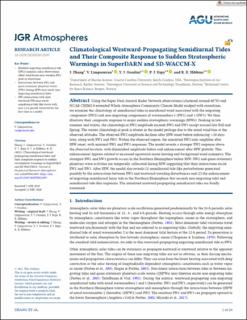| dc.contributor.author | Zhang, Z. | |
| dc.contributor.author | Limpasuvan, Varavut | |
| dc.contributor.author | Orsolini, Yvan J. | |
| dc.contributor.author | Espy, Patrick Joseph | |
| dc.contributor.author | Hibbins, Robert | |
| dc.date.accessioned | 2021-02-16T12:26:47Z | |
| dc.date.available | 2021-02-16T12:26:47Z | |
| dc.date.created | 2021-02-15T09:48:24Z | |
| dc.date.issued | 2021 | |
| dc.identifier.citation | Journal of Geophysical Research (JGR): Atmospheres. 2021, 126 (3), . | en_US |
| dc.identifier.issn | 2169-897X | |
| dc.identifier.uri | https://hdl.handle.net/11250/2728386 | |
| dc.description.abstract | Using the Super Dual Auroral Radar Network observations (clustered around 60°N) and NCAR CESM2.0 extended Whole Atmosphere Community Climate Model nudged with reanalyzes, we examine the climatology of semidiurnal tides in meridional wind associated with the migrating component (SW2) and non‐migrating components of wavenumbers 1 (SW1) and 3 (SW3). We then illustrate their composite response to major sudden stratospheric warmings (SSWs). Peaking in late summer and winter, the climatological SW2 amplitude exceeds SW1 and SW3 except around late Fall and Spring. The winter climatological peak is absent in the model perhaps due to the zonal wind bias at the observed altitudes. The observed SW2 amplitude declines after SSW onset before enhancing ∼10 days later, along with SW1 and SW3. Within the observed region, the simulated SW2 only amplifies after SSW onset, with minimal SW1 and SW3 responses. The model reveals a stronger SW2 response above the observed location, with diminished amplitude before and enhancement after SSW globally. This enhancement appears related to increased equatorial ozone heating and background wind symmetry. The strongest SW1 and SW3 growth occurs in the Southern Hemisphere before SSW. SW2 and quasi‐stationary planetary wave activities are temporally collocated during SSW suggesting that their interactions excite SW1 and SW3. After SSW, the model also reveals (1) semidiurnal‐tide‐like perturbations generated possibly by the interactions between SW2 and westward‐traveling disturbances and (2) the enhancement of migrating semidiurnal lunar tide in the Northern Hemisphere that exceeds non‐migrating tidal and semidiurnal‐tide‐like responses. The simulated eastward‐propagating semidiurnal tides are briefly examined. | en_US |
| dc.language.iso | eng | en_US |
| dc.publisher | American Geophysical Union | en_US |
| dc.rights | Attribution-NonCommercial-NoDerivatives 4.0 Internasjonal | * |
| dc.rights.uri | http://creativecommons.org/licenses/by-nc-nd/4.0/deed.no | * |
| dc.title | Climatological Westward‐Propagating Semidiurnal Tides and Their Composite Response to Sudden Stratospheric Warmings in SuperDARN and SD‐WACCM‐X | en_US |
| dc.type | Peer reviewed | en_US |
| dc.type | Journal article | en_US |
| dc.description.version | publishedVersion | en_US |
| dc.source.volume | 126 | en_US |
| dc.source.journal | Journal of Geophysical Research (JGR): Atmospheres | en_US |
| dc.source.issue | 3 | en_US |
| dc.identifier.doi | 10.1029/2020JD032895 | |
| dc.identifier.cristin | 1889713 | |
| dc.relation.project | NILU - Norsk institutt for luftforskning: 118005 | en_US |
| dc.relation.project | Norges forskningsråd: 274377 | en_US |
| dc.relation.project | Norges forskningsråd: 223252 | en_US |
| dc.description.localcode | This is an open access article under the terms of the Creative Commons Attribution‐NonCommercial‐NoDerivs License, which permits use and distribution in any medium, provided the original work is properly cited, the use is non‐commercial and no modifications or adaptations are made. | en_US |
| cristin.ispublished | true | |
| cristin.fulltext | original | |
| cristin.qualitycode | 2 | |

